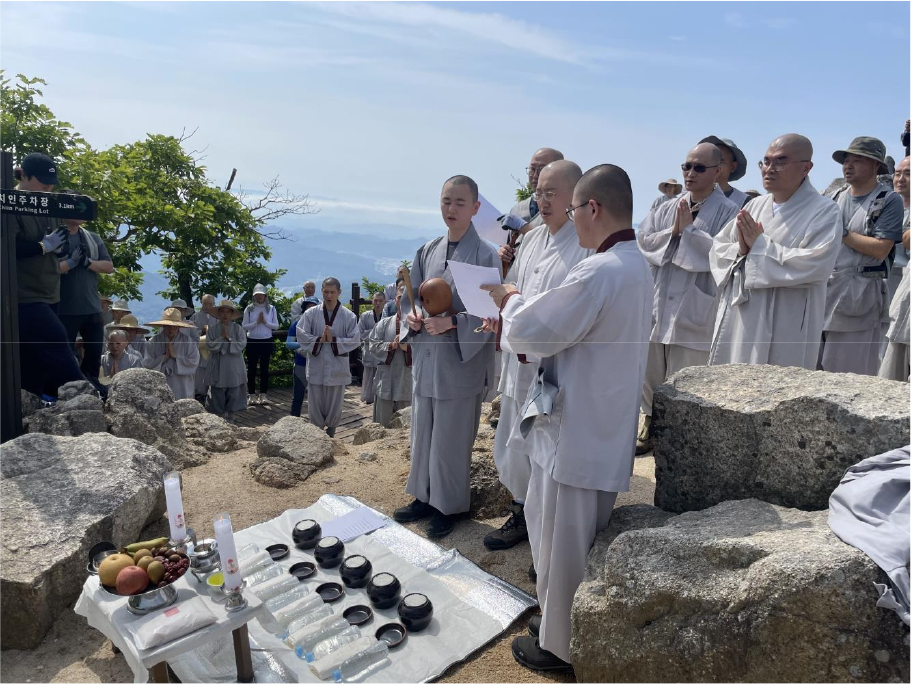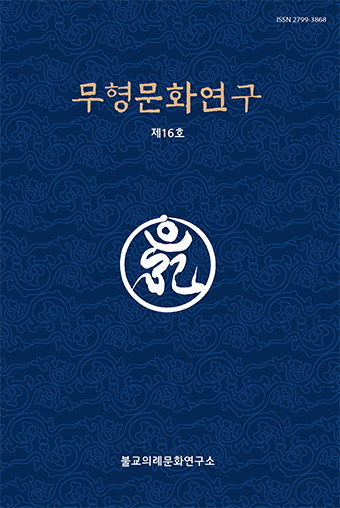-
일반논문

-
고려시대 무불습합(巫佛習合)의 현상과 불교적 관점
The Phenomenon of Fusion of Shamanism and Buddhism during the Goryeo Dynasty and its Buddhist Perspective
-
이병욱
Lee Byungwook
- 이 글에서는 고려시대의 무불습합의 현상을 설명하고, 그것을 불교의 관점에서 어떻게 바라보아야 할 것인지 살펴보고자 한다. 2장에서 고려시대 무격의 역할과 무교의 전개과정에 대해 …
In this article, I will explain the phenomenon of fusion of shamanism and buddhism during the Goryeo Dynasty and examine how it …
- 이 글에서는 고려시대의 무불습합의 현상을 설명하고, 그것을 불교의 관점에서 어떻게 바라보아야 할 것인지 살펴보고자 한다. 2장에서 고려시대 무격의 역할과 무교의 전개과정에 대해 간단히 알아본다. 3장에서는 고려시대의 무불습합의 현상으로 팔관회, 제석신앙과 무교의 습합에 대해 살펴본다. 제석신앙과 무교의 습합은 『삼국유사』 고조선 조항에서 일연이 환인(桓因)이 제석이라고 주석한 대목에서 확인할 수 있다. 4장에서는 만해 한용운이 고려시대 무불습합의 현상에 대해 비판한 내용을 알아보고, 그 주장의 한계를 밝히며, 방편의 관점에 대해 알아본다. 만해 한용운은 『조선불교유신론』에서 무불습합의 현상에 대해 비판적 견해를 제시하는데, 그것은 깨달음의 경지에서 논의를 전개하거나 또는 상식적인 논리추론에 의거한 것이다. 필자는 이러한 한용운의 주장에 동의한다. 그런데 한용운은 더 한 걸음 나가서 방편의 관점에서 무불습합의 주장을 수용하자는 견해에 대해서도 비판한다. 그 주장의 요점은 종교적 신념의 대상은 한 가지이고 여러 가지가 될 수 없고 만약 종교적 신념의 대상이 된다면 오히려 종교적 신념이 성립될 수 없다고 하는 것이다. 이는 치우친 주장이다. 왜냐하면, 삶의 현장에서 여러 대상을 신앙하는 것이 자연스럽게 이루어질 수 있기 때문이다. 그래서 방편의 관점이 필요한데, 그 방편의 정신이 잘 나타난 불교경전의 하나가 『법화경』이다. 그래서 『법화경』에 따르면 중생의 근기가 다양하기 때문에 방편이 필요하다고 한다. 이것이 바로 방편의 정신을 말하는 것이다. 이런 관점에서 무불습합의 가르침을 제한적으로 수용할 수 있다.
- COLLAPSE
In this article, I will explain the phenomenon of fusion of shamanism and buddhism during the Goryeo Dynasty and examine how it should be viewed from a buddhist perspective. In chapter 2, I will briefly examine the role of shamans and the development of shamanism during the Goryeo Dynasty. In chapter 3, I will examine the phenomenon of fusion of shamanism and buddhism during the Goryeo Dynasty, including Palgwanhoe and the fusion of Indra belief and shamanism. This fusion of Indra belief and shamanism can be confirmed in Samguk Yusa Gojoseon article, where Iryeon annotates Hwanin(桓因) as Indra. In chapter 4, I will examine Han Yong-un's critique of the phenomenon of fusion of shamanism and buddhism during the Goryeo Dynasty, and I expose the limitations of his argument and examine the expedient perspective. In Joseon bulgyo yusillon(朝鮮佛敎維新論), he presents a critical view of the phenomenon of fusion of shamanism and buddhism, developing his argument from a state of enlightenment or relying on common-sense logical reasoning. I agree with Han Yong-un's argument. However, he goes a step further and criticizes the idea that the fusion of shamanism and buddhism should be accepted from an expedient perspective. The point of the argument is that the object of religious belief can be only one thing and not multiple things, and if multiple things were the object of religious belief, then religious belief would not be established. This is a biased argument because in everyday life, faith in multiple objects can naturally occur. Therefore, a perspective of expedient is necessary, and one sutra that best embodies this expedient spirit is Lotus Sutra. Therefore according to Lotus Sutra, expedient means is necessary because the religious capacity of sentient beings are diverse. This is precisely the spirit of expedient means. From this perspective, the fusion of shamanism and buddhism can be accepted to a limited extent.
-
고려시대 무불습합(巫佛習合)의 현상과 불교적 관점
-
일반논문

-
한국불교 다비의 역사적 전개
The Historical Development of Korean Buddhist Cremation
-
이재수
Lee, Jaesoo
- 한국불교의 다비(茶毘, jhāpita)는 죽은 이의 시신을 화장하는 장례법으로 불교의 전래와 함께 정착되었다. 본 논의는 우리나라에서 다비가 어떻게 정착되었고, 그 역사적 전개와 특징은 …
In Korean Buddhism, cremation (茶毘, jhāpita) is a funeral practice that became established with the introduction of Buddhism. This discussion examines how …
- 한국불교의 다비(茶毘, jhāpita)는 죽은 이의 시신을 화장하는 장례법으로 불교의 전래와 함께 정착되었다. 본 논의는 우리나라에서 다비가 어떻게 정착되었고, 그 역사적 전개와 특징은 무엇인지를 살펴보는 것이다.
신라에서 왕이 죽으면 매장하여 성대한 무덤을 세우는 것이 상례였지만, 불교식 화장을 치른 왕은 30대 문무왕(681년)이었다. 그 이후 모두 8명의 왕이 화장을 통해 불교식 장례를 치렀다. 자장스님을 시작으로 고승들이 열반한 이후 다비하고 사리탑과 비석을 세우기 시작한 전통이 자리를 잡았다. 석조 부도를 건립하기 시작한 전통은 선종의 성행과 함께 시작되어 구산선문의 성립으로 자리를 잡았다. 고승의 사후에 다비를 하고 사리를 수습하여 사리탑과 비석을 세운 것은 한국불교의 중요한 전통이 되었다.
고려시대에는 다비를 하고 뼈를 뿌리거나 수습하여 부도를 건립하는 것이 전통이 되었음을 고려의 묘지명을 통해서 다비를 행한 사례로 52명을 분석하였다. 또한 일반 스님들은 다비를 하고 뼈를 물에 뿌렸지만, 고승은 탑에 봉안하는 장례법이 정착되었다는 것을 밝혔다.
조선시대에는 불교식 장례의식을 정리한 의례집이 간행되면서 다비의례가 보편화되었다. 특히 백파긍선(白坡亘璇)의 다비설(茶毘說)은 다비를 선사상의 입장에서 바라보고 있다는 점이 중요하며, 이러한 흐름이 자리를 잡았다. 본 논의에서는 여러 문집과 기록을 통해서 조선시대 다비를 행할 때 나타난 상황들을 정리하였다. 다비의례를 올린 이후 신비로운 빛이 비치고 오색의 구름이 출현하는 등의 이적을 기록하여 고승의 수행 결과라고 보았다.
본 논의를 통해 다비는 한국불교의 신앙적인 특성을 보여주는 중요한 의례이며, 선과 염불 수행을 통해 고승의 정신적인 가치를 사회화하려는 의례라는 중요한 의미를 가진다. 이러한 소중한 전통은 한국불교의 고유성을 현재화 하려는 시도로 중요하게 계승해야 한다.
- COLLAPSE
In Korean Buddhism, cremation (茶毘, jhāpita) is a funeral practice that became established with the introduction of Buddhism. This discussion examines how cremation became established in Korea, its historical development, and its characteristics. In Silla, it was customary to bury a king and build a magnificent tomb when he died, but the only king to perform a Buddhist cremation was King Munmu (681), the 30th king. Since then, a total of eight kings have performed Buddhist funerals through cremation. Beginning with Monk Jajang, the tradition of cremating the bodies of eminent monks and erecting stupas and monuments after their deaths has taken root. The tradition of building stone stupas began with the rise of Seon Buddhism and was established with the establishment of the Nine Mountains Seon School. Cremating eminent monks and collecting their sarira to erect stupas and monuments has become an important tradition in Korean Buddhism. During the Goryeo Dynasty, cremation and the scattering or collection of ashes to build a stupa became a tradition. This study analyzed 52 cases of cremation using Goryeo epitaphs. Furthermore, it revealed that while ordinary monks cremated and scattered the ashes in water, eminent monks established a more established funeral practice of enshrining the remains in a pagoda. During the Joseon Dynasty, the practice became widespread with the publication of ritual books outlining Buddhist funeral rites. Baekpa Geungseon's (白坡亘璇, 1767-1852) “Dabi Seol (茶毘說)” is particularly notable for its perspective on cremation from a Seon perspective, which helped establish this trend. This discussion summarizes the circumstances surrounding cremation during the Joseon Dynasty, examining various anthologies and records. After the cremation, miraculous signs, such as the appearance of mystical lights and multicolored clouds, were recorded, which were attributed to the monks' spiritual practices. This discussion demonstrates that cremation is a crucial ritual that demonstrates the religious characteristics of Korean Buddhism, and holds significant significance as a ritual that socializes the spiritual values of eminent monks through the practice of Seon and chanting. This precious tradition must be preserved as an important attempt to modernize the uniqueness of Korean Buddhism.
-
한국불교 다비의 역사적 전개
-
일반논문

-
『경우천축자원』을 통해 본 11세기경 중국의 실담장(悉曇藏)* -『실담자기』와의 비교를 통하여-
A study on Chinese Siddhavastu around the 11th century through the Keiyū India's Syllabary source –through comparison with Xitan ziji–
-
강대현
Kang, Dae-hyun
- 본 연구에서는 11세기경 중국의 실담장을 살펴 보았다. 800년 전후 찬술된 지광의 『실담자기』 이후 200년 이상이 지난 시기 실담장의 양상을 살펴보기 위함이다. 1035년에 …
In this study, we looked at Chinese Siddhavastu around the 11th century. This is to examine the aspect of Siddhavastu for a …
- 본 연구에서는 11세기경 중국의 실담장을 살펴 보았다. 800년 전후 찬술된 지광의 『실담자기』 이후 200년 이상이 지난 시기 실담장의 양상을 살펴보기 위함이다. 1035년에 찬술된 전7권의 『경우천축자원』은 형식상 『실담자기』의 구성과 일치하는 부분이 많으나 『실담자기』에 비해서 해설이 많지 않고, 전체적으로 일반화된 실담장에 대한 실재적인 예를 보여주는 내용으로 구성되어 있다. 『실담자기』에는 나타나고 있지 않는 34체문과 ña 및 ṇa의 결합에 대한 내용이 대표적이고, 『실담자기』에 나타나고 있는 ‘訖里(kṛ)章’은 『경우천축자원』에는 나타나고 있지 않지 않으며, 특히 『실담자기』에서는 전혀 언급되고 있지 않으나 대부분의 경전에서는 12전성과 34체문에 대한 기본적인 자의(字義)만 나타나고 있는데 반해 『경우천축자원』에서는 12전성과 34체문이 결합하여 생성된 모든 문자에 대한 자의를 한 권 전체를 통해 해설하고 있다. 또한 네 권에 걸쳐 12전성과 34체문이 결합하는 예를 들어 설명함으로써, 전체적으로 『실담자기』가 범자를 처음 접하는 자를 위한 기초 교본이라면 『경우천축자원』은 당시까지 통용되고 있던 범자에 대한 대표적인 실용서라고 할 수 있을 것이다.
- COLLAPSE
In this study, we looked at Chinese Siddhavastu around the 11th century. This is to examine the aspect of Siddhavastu for a period more than 200 years after Zhiguang's Xitan ziji, which was written around 800 years ago. The seven-volume Keiyū India's Syllabary source, written in 1035, has many parts that are similar in format to the Xitan ziji, but compared to the Xitan ziji, it does not have as many commentaries, and overall, it is composed of content that shows actual examples of generalized Siddhavastu. Representative examples include the 34 syllables that do not appear in the Xitan ziji and the combination of ña and ṇa, the ‘訖里(kṛ)章’ that appears in the Xitan ziji does not appear in the Keiyū India's Syllabary source, in particular, it is not mentioned at all in the Xitan ziji, but in most scriptures, only the basic meanings of the 12 declension vowels and 34 consonants are shown, whereas in the Keiyū India's Syllabary source, the meanings of all letters created by combining the 12 declension vowels and 34 consonants are explained in an entire volume. furthermore, by explaining the combination of the 12 declension vowels and 34 consonants through examples across four volumes, if the Xitan ziji is a basic textbook for those encountering Sanskrit for the first time, the Keiyū India's Syllabary source can be said to be a representative practical book on Sanskrit that was in common use until then.
-
『경우천축자원』을 통해 본 11세기경 중국의 실담장(悉曇藏)* -『실담자기』와의 비교를 통하여-
-
일반논문

-
단오와 불교의 단오
Dano and Buddhist Dano
-
성청환
Sung, Chungwhan
- 본 논문에서는 현재 국가무형유산으로 지정되어 있는 단오행사들의 특징을 살펴본다. 그리고 기존의 전통적 단오놀이의 성격과 구분되는 불교에서 행해지는 단오절의 행사를 주요 사찰을 중심으로 …
This paper examines the characteristics of Dano and Buddhist Dano ceremonies, distinct from traditional Dano games, focusing on major temples. I examine …
- 본 논문에서는 현재 국가무형유산으로 지정되어 있는 단오행사들의 특징을 살펴본다. 그리고 기존의 전통적 단오놀이의 성격과 구분되는 불교에서 행해지는 단오절의 행사를 주요 사찰을 중심으로 살펴본다. 이를 통해서 불교의 단오가 기존의 단오와는 확연히 구분되는 소금묻기 의례를 통해서 화재예방을 통한 사찰의 평안을 염원하는 의미를 살펴본다.
불교의 연중 행사는 많은 부분 절기(節氣)에 기반한 세시풍속과 궤를 같이 한다. 백중날 행해지는 조상 천도를 위한 우란분절(盂蘭盆節)이나, 동지 같은 풍습은 전국의 모든 사찰의 중요한 일정으로 기본적 구조는 동일하나, 저마다의 특색을 지니며 지금도 여전히 활발하게 전승되고 있다. 그러나 단오를 맞이하는 불교계의 모습은 이와는 다르다. 전통적으로는 모든 사찰이 단오절을 명절로 크게 여겼지만, 도시화된 오늘날은 사찰들이 저마다의 사정과 형편을 고려하여, 단오절을 챙기기도 하고 생략하기도 한다. 서울의 대표적인 사찰인 조계사는 단오재를 크게 하지만, 봉은사는 특별한 행사 없이 지나간다.
해인사, 통도사 등의 사찰마다 단오를 맞이하는 행사의 명칭과 의식은 조금씩 다르지만, 화재 등 재난의 위험을 예방하고 사부대중 모두의 안녕과 평안을 기원하는 의미는 같다. 우리의 많은 세시풍속 중에서 많은 부분을 전승해 온 집단은 불교권이 유일하다. 불교에서 봉행하고 있는 단오는 민간 세시의 풍습을 수용하면서도 불교 고유의 요소를 부가하여 독특한 한국 문화의 한 요소를 형성하고 있다.
단오날의 의례를 행하는 행위의 주체가 민간과 사찰이 다르고, 목적이 다르기에 의례의 일련의 행위 과정도 뚜렷이 구분된다. ‘용왕제’와 ‘소금 묻기’는 마을공동체에서 점차 사라져가는 단오의 문화를 사찰에서는 사부대중이 함께 삼보(三寶)를 지키는 종교공동체의 신심을 기반으로 하고 있어, 튼실한 기반으로 전승되고 있다. 세시를 근간으로 한 전통문화 계승의 교두보로서 불교의 역할이 돋보이는 대표적인 사례들이다.
소금으로 상징되는 불교의 단오절의 역사성과 전승 현황 등은 충분히 입증되고 있지만, 이에 따른 불교 교리의 경전적 근거와 민간의 세시풍속에서 불교의 풍습으로 받아들인 구체적인 전거에 대한 증빙은 향후 지속적으로 고찰되어야 할 무거운 연구 주제이다.
- COLLAPSE
This paper examines the characteristics of Dano and Buddhist Dano ceremonies, distinct from traditional Dano games, focusing on major temples. I examine how Buddhist Dano, distinct from traditional Dano, utilizes the salt-smearing ritual, a practice that prays for the peace of the temple through fire prevention. The Buddhist community's approach to Dano differs. Traditionally, all temples celebrated Dano as a major holiday. However, in today's urbanized world, temples sometimes celebrate Dano or omit it, depending on their individual circumstances and circumstances. Jogyesa Temple, a prominent temple in Seoul, holds a grand Danojae, while Bongeunsa Temple passes it by without any special events. Temples like Haeinsa Temple and Tongdosa Temple have slightly different names and rituals for their Dano ceremonies, but their common purpose is to prevent fires and other disasters and to pray for the well-being and peace of all the four classes of people. Buddhism is the only group that has preserved a significant portion of Korea's numerous seasonal customs. Dano, as observed by Buddhism, incorporates folk customs while incorporating unique Buddhist elements, forming a unique element of Korean culture. Because the subjects of Dano rituals and the purposes of the rituals differ between the private sector and temples, the sequence of rituals is also distinct. The ‘Yongwangje’ (Dragon King Ritual) and ‘Salt Burying’ rituals, which are gradually disappearing from village communities, are being passed down in temples, firmly rooted in the faith of a religious community where the four classes of people work together to protect the Three Treasures. These are representative examples that highlight Buddhism's role as a bridgehead for the inheritance of traditional culture based on seasonal rituals. While the historical significance and current status of Dano, symbolized by salt, are well-documented, the scriptural basis for Buddhist doctrine and the specific evidence for its acceptance as a Buddhist custom within folk customs are significant research topics requiring ongoing investigation.
-
단오와 불교의 단오
-
일반논문

-
불교민속놀이 <삼회향(속칭 땅설법)>의 공연 음악 연구 -경기 서북부와 서울(京制)을 중심으로
Research on the musical performance of the Buddhist folk game of samhoehyang (三回向)
-
손인애
Son, In-EA
- 본고는 과거 경기 서북부지역과 서울, 소위 경제(京制) 불교음악에서 큰 재의식이 끝난 뒤 준비한 대중들의 노고와 인연 공덕을 치하하며 뒤풀이로 연행되었던 <삼회향>의 공연 …
This essay looks at the musical performance characteristics and composition of samhoehyang (三回向), a performance that serves as a causal and entertaining …
- 본고는 과거 경기 서북부지역과 서울, 소위 경제(京制) 불교음악에서 큰 재의식이 끝난 뒤 준비한 대중들의 노고와 인연 공덕을 치하하며 뒤풀이로 연행되었던 <삼회향>의 공연 음악적 성격과 그 구성미(構成美)를 살펴보았다.
첫 번째 순서인 회향설법은 판소리처럼 설법(아니리)과 민요조 염불(소리)을 섞어가며 포교하는 설창(說唱) 특유의 공연 음악적 성격을 지니고 있었다. 이러한 회향설법을 통해, 불법을 민중들의 눈높이에 맞춰 재미있게 전하면서 장엄한 재의식에서는 미처 표현하지 못했던 마음이나 내용들을 허심탄회하게 전하는 시간도 가졌다. 두 번째 축원덕담 절차에서는 고사염불 계통과 함께 상단과 중단의 마지막 재의식에서 부른 <화청> 계통 염불(<(일반)화청>〻<축원화청>)도 불렀던 사실이 확인되어, 소위 민요조 염불은 이 절차에서 적극적으로 활용되었다. 즉, <삼회향>에서는 대중들의 음악적 취향과 눈높이를 반영한 염불(민요조)을 잘 이용하여, 부처님의 가르침을 보다 전달력 있고 효과적으로 전하였다. 세 번째 무용 절차에서는 흥겹고 신명나는 불교무용(법고춤·바라춤)이나 불교의 세계관에 나름 상응하는 세간의 춤(학춤)을 추었고, 반주음악도 모두 민중들의 음악적 취향에 맞추면서, 큰 재의식의 환희심과 감사함을 민중들과 신명나게 풀어내는 시간을 가졌다. 네 번째 이른바 잡희 절차는 <삼회향> 뒤풀이의 진정한 하이라이트 부분으로, 관계 대중 모두가 참여하여 가면연희와 춤, 음악으로 그간 애쓴 재의식의 노고를 가장 즐겁고 흥겹게 풀어내는 과정이었다. 공연 음악은 민중들의 음악인 민속악(성악·기악·타악)이 중심이 되었고, 이를 통해 현재 전승되고 있는 산대가면극 놀이문화가 과거 절에서도 <삼회향>에서 전승되었던 사실을 알 수 있다. 마지막 <삼회향>의 대단원은 모든 대중들이 탑돌이를 통한 소원성취 발원과 회향문 염송으로 뒤풀이의 여흥을 차분하게 마무리하였다. 그리고 탑돌이는 민요(경기민요 <탑돌이>의 모체)와 염불이 아우러져 연행되었으며, 이를 통해 민중들과 함께 한 불교 민속놀이의 진수를 엿볼 수 있다.
요컨대, 경제(京制) 불교음악의 <삼회향>도 궁극적으로 큰 재의식을 한 후, 화합과 축제의 창으로 민중들과 신명나게 뒤풀이를 펼친 불교 민속놀이였음이 확인된다. 그리고 <삼회향>의 전체 공연 음악적 특성으로 볼 때, 첫 번째 절차가 설창을 통해 시작(起)의 역할을 하고, 두 번째 축원덕담과 세 번째 무용 절차가 공연의 신명을 일으키며(承), 네 번째 잡희 절차가 그 절정을 이루고(轉), 다섯 번째 회향 절차가 마무리(結)를 하며, 기승전결의 짜임새 있는 구성미(構成美)가 잘 나타난다. 경제 <삼회향>은 삼국시대의 기악, 고려시대의 산대잡희, 조선시대의 <삼회향>까지 이어지는 불교 민속놀이의 역사적 맥락을 여실히 확인할 수 있어, 그 의의가 크다. 앞으로 이러한 특성을 온고이지신(溫故而知新)하여 21세기식 <삼회향>을 만들어낸다면, 미래 불교 공연 문화의 포교와 대중화, 현대화에 분명 큰 역할을 하리라 기대된다.
- COLLAPSE
This essay looks at the musical performance characteristics and composition of samhoehyang (三回向), a performance that serves as a causal and entertaining social gathering following a large food-offering ritual within the context of gyeongje (京制) Buddhist music. The first part of samhoehyang, the hoehyang homily, is a traditional style of talk–singing with its own specific musical characteristics that, similar to pansori, combines both homily (narrative) and folk-style Buddhist chanting (sound), for the purpose of proselytizing Buddhist doctrine. Hoehyang homily appeals to the sensibilities of the masses in order to transmit Buddhist doctrine in an entertaining manner while enabling for the open expression of emotions and other content that had been difficult to express through food-offering rituals. Additionally, it appears that the next stage of the samhoehyang, the prayer and well-wishing stage (chugwondeokdam祝願德談), incorporated the traditions of both gosa (告祀) Buddhist chanting and hwacheong (和請) Buddhist chanting, indicating that folk-style chanting was actively used within this ritual. That is, samhoehyang utilized (folk-style) Buddhist chanting practices that reflected the musical tastes of the masses and their needs. In this way, it effectively transmitted the teachings of the Buddha. In the third stage, which is the dancing stage, participants performed lively and exciting Buddhist dances and other dances that in some way conformed to a Buddhist worldview. The accompanying music also aligned with popular taste, providing participants with a rousing experience that expressed the joy and gratitude for the large food-offering ritual. The fourth stage, the japui (雜戲) stage, is the highlight of samhoehyang; all of the attendees participate, and it offers an enjoyable release through music following the difficult work of the food-offering ritual. The musical particularity of this performance is that it centers on popular folk music, indicating that the folk performances of Korean mask dances, which continue to be passed down to this day, were formerly performed at temples as a part of samhoehyang. In the final stage of the samhoehyang, the gathering comes to a calm conclusion through the acts of pagoda-circling (tapdori탑돌이) as a means of making prayers for wishes and reciting a transfer of merit (hoehyang). Moreover, it appears that pagoda-circling involved the combination of both folk songs (the Gyeonggi folk song “Tapdori”) and Buddhist chanting. In this way, it offers a glimpse into the essence of Buddhist folk games that included the common people. This paper confirms that samhoehyang, which belongs to gyeonje-style Buddhist music, was a Buddhist folk game that offered a fun and exciting social gathering that included common folk following a large food-offering ritual. Moreover, when considering the overall musical characteristics of samhoehyang, the first stage functions as a beginning via talk–singing. The second and third stages, which are the prayer and well-wishing stage and the dancing stages, respectively, bring excitement to the performance. The fourth stage, the japui stage, is the climax of the event, and the fifth stage, the transfer of merit stage, offers a conclusion. In this way, its composition has a beginning, a development, and an ending. Gyeongje-style samhoehyang is of great significance, as it capture the history of Buddhist folk games from the kiak (伎樂) of the Three Kingdoms period to the sandae japui (山臺雜戲) of Goryeo and the samhoehyang of the Choseon dynasty.
-
불교민속놀이 <삼회향(속칭 땅설법)>의 공연 음악 연구 -경기 서북부와 서울(京制)을 중심으로
-
일반논문

-
대성사 소장 소미타참서 보존처리
Conservation Treatment of Somitachamseo in the Collection of Daeseongsa Temple (Summary)
- 허은미, 김청솔
- 대성사 소장 소미타참서(서울특별시 유형문화유산)는 2023년 시지정문화재 보수 사업의 일환으로 2023년 9월 24일부터 2024년 7월 16일까지 보존처리를 진행하였다.
우선 소미타참서를 대성사에서 ㈜엔가드 보존처리 …
Somitachamseo housed at Daeseongsa Temple (Designated as Tangible Cultural Heritage of Seoul Metropolitan Government) underwent conservation treatment from September 24, 2023, to …
- 대성사 소장 소미타참서(서울특별시 유형문화유산)는 2023년 시지정문화재 보수 사업의 일환으로 2023년 9월 24일부터 2024년 7월 16일까지 보존처리를 진행하였다.
우선 소미타참서를 대성사에서 ㈜엔가드 보존처리 작업실로 무진동차량을 이용하여 이운하였고, 적절한 보존환경이 유지되는 곳에서 형태, 손상상태, 과학적 조사를 진행하여 보존처리계획서를 작성하였다. 이 후 보존처리계획에 대한 서울시 심의 승인 이후 보존처리를 진행하였다.
소미타참서는 1579년 제작 이래 불교의식을 행할 때 활용되어 오면서 표지, 장정끈이 결실되었고, 내지에 보수지가 덧붙여져 두께 변형과 얼룩손상이 존재하였다. 보존처리 작업으로 남아있는 원형의 표지를 토대로 표지 제작, 내지 보수, 장정을 통해 원래의 형태를 회복하였다. 이번 사업의 결과 서적 열람의 용이, 학술자료로의 활용, 보존수명 연장 및 가치 증진이 기대된다.
- COLLAPSE
Somitachamseo housed at Daeseongsa Temple (Designated as Tangible Cultural Heritage of Seoul Metropolitan Government) underwent conservation treatment from September 24, 2023, to July 16, 2024, as part of the 2023 City-Designated Cultural Heritage Conservation Project. To begin the treatment, Somitachamseo has been moved to ⓒENGUARD conservation studio in a low-vibration vehicle, and the visual and technical examination on its structures and damages has been conducted in the climate-controlled environment to produce the treatment proposal. The treatment has been carried out on the approval of the conservation proposal by Seoul Metropolitan Government. Since its production in 1579, the manuscript had been used in Buddhist rituals, during which its covers and the binding cords were lost, and repair papers were attached to the inner leaves, causing uneven thickness and stains. Through the conservation treatment, the covers that are restored based on the remaining original fragments and the repaired inner leaves are bound together to recover its original form. As a result of this project, the manuscript is now more accessible for reading, can be more effectively utilized as scholarly material, and its longevity and cultural value are expected to be significantly enhanced.
-
대성사 소장 소미타참서 보존처리
-
해외논단
- 신화, 우주, 그리고 사회-창조와 파괴에 관한 인도유럽인들의 주제들- 1장과 2장의 요약 -Bruce Lincoln(1986), Myth, Cosmos, and Society: Indo-European Themes of Creation and Deconstruction, Cambridge: Harvard University Press
- 브루스 링컨(Bruce Lincoln) / 번역요약 심재관
- 링컨의 이 책은 일반 창조신화의 개론적 서술-각 지역별 창조신화의 나열이 갖는 단순성을 피하고, 대신 창조신화 사이에 내재해 있는 공통성을 몇 장에 나누어 …
- 링컨의 이 책은 일반 창조신화의 개론적 서술-각 지역별 창조신화의 나열이 갖는 단순성을 피하고, 대신 창조신화 사이에 내재해 있는 공통성을 몇 장에 나누어 기술하고 있다. 따라서, 그는 인도유럽피언 신화에서 나타나는, 대우주-소우주의 동일적 인식을 전제로 한 상태에서, 희생제, 음식의 순환, 머리카락, 죽음과 회생, 등을 논한다. 먼저, 그는 인도유럽피언 신화에 광범위하게 나타나는 우주기원설(Cosmogony)과 인간기원설(Anthropogony)의 여러 형태들을 제시하고 그 속에서 개인의 신체적 구성요소와 거시적 자연의 상동성(Homology)이 어떻게 전개되는지 보여준다. 그 전개과정은 대체로 “절단(dismemberment)"과 “결합”의 행위로 이루어지는데, 전자의 경우, 그 절단의 행위는 인도유럽피언의 희생제와 밀접한 관계에 놓인다. 아래는 25년전의 요약문이기에 오류가 있을 수 있으니 주의할 필요가 있다. - COLLAPSE


 Intangible Culture
Intangible Culture





